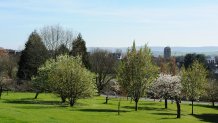Articles

The trees remove over two tonnes of pollutants each year, which equates to a value of more than £21,000
Tree-mendous benefits from campus ecosystem
Mature trees at the University of Exeter have an annual economic value of more than £46,000, a recent survey has shown.
The survey, which took place in 2018 as part of the University’s on-going tree management programme, recorded over 5,274 mature trees (including groups) across the Streatham and St Luke’s campuses, and found that the University of Exeter’s trees remove over two tonnes of pollutants each year, which equates to a value of more than £21,000. This monetary value is calculated based on the UK social damage cost (UKSDC), published by DEFRA, which includes health costs and damage to buildings.
The trees also store 3,195 tonnes of carbon with a value of more than £760,000 and the annual removal of CO2 from the air by plants, known as the Annual Carbon Sequestration, is 67 tonnes, worth more than £15,000.
Findings also showed that the University of Exeter’s trees divert 5,460 cubic meters of storm water runoff away from local sewer systems annually, which is worth more than £8,000 each year. The Monterey Pine trees on campus were found to reduce runoff more than all the other species due to its population and canopy size.
The value of these benefits is used to calculate an economic value, which can be used to inform land management decisions and help optimise biodiversity, as well as allowing the University to improve its economic sustainability and reduce its carbon footprint.
The overall economic value of the University of Exeter’s trees is £46,123, which is a significant rise from the previous survey in 2009 - £20,874. The total replacement value of the trees currently stands at more than £10.5m.
Iain Park, Director of Grounds at the University of Exeter, said: “We are the custodians of a unique asset on our Exeter campuses. Not only do we have one of the widest range of tree species of any UK University, with the largest number of ‘Champion Trees’, the surveys confirm that they have a proven environmental and economic benefit.
“The Grounds offer our students and staff recognised positive impacts on health and well-being, which we share with the wider community by granting ‘Permitted Access’ to our sites.
“In addition, our 153 hectare estate has a positive impact on the biodiversity, habitat and environment of the city and wider South West region.
“The Grounds team work hard to continue to preserve and enhance this award-winning asset, as part of their on-going custodianship of historic and new landscapes in their care. It is great to be able to allocate an accepted economic value to the trees on the estate.”
The i-Tree Eco Inventory Report, was prepared for the University of Exeter by Treeconomics, a company that measures and highlights the value of trees.
The figures in the report were calculated using mathematical system, i-Tree Eco. The software system combines the data from the University’s campus tree survey, such as tree species, diameter, height, crown width and tree health data (for an estimate of canopy cover), with local pollution and climate data, to produce the figures.
Date: 14 January 2019
